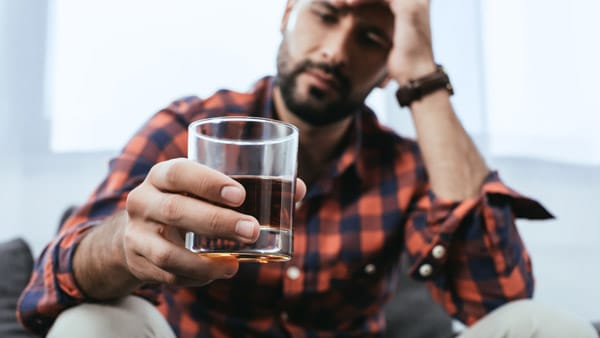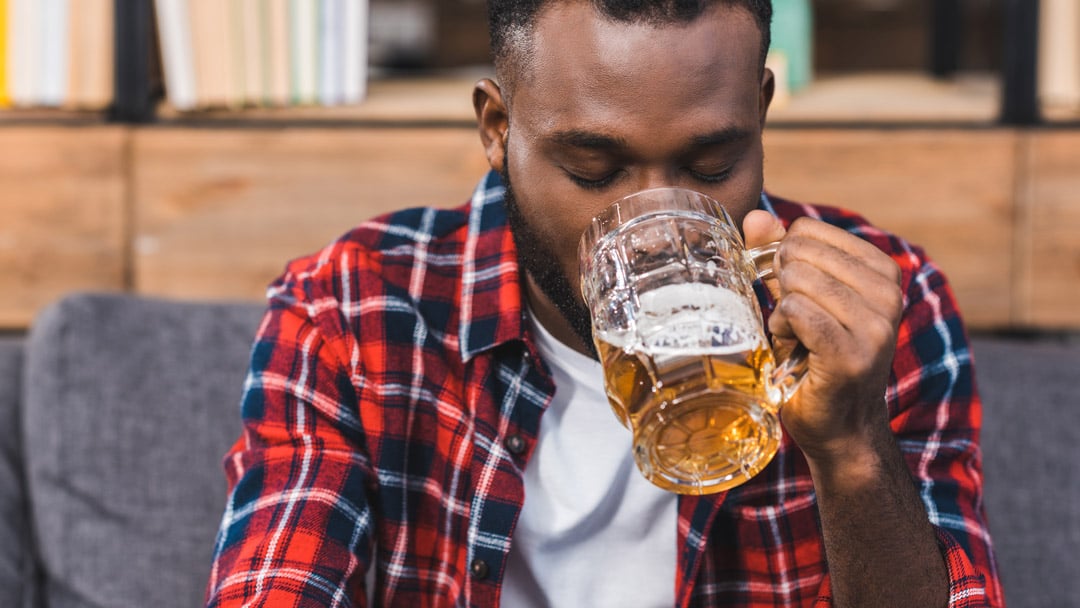Of all the hilarious lines uttered by animated TV icon Homer J. Simpson over the years, there’s one that often springs to mind while I’m working: “To alcohol! The cause of, and solution to, all of life’s problems.”
As one of the registered counsellors providing private video appointments at TELUS Health MyCare™, I hear from many guys who have noticed that the amount of alcohol they drink at home has increased over the pandemic. These men still want to enjoy a beer or a glass of wine from time to time and are simply looking for strategies on how to cut back.
If you can relate, here are some tips on how to drink less by changing your drinking habits at home.
Simple ways to drink less alcohol

Most of the guys I counsel want to enjoy alcohol but without the hangovers, costs and health problems that go along with it. That’s when I tell them they don’t need to give up beer, wine, or their favourite cocktails altogether to reduce risks to their health, happiness and finances.
Since most people are creatures of habit, successfully lowering your alcohol intake often involves changing up, you guessed it, your habits. Here are 5 key ways this can be done:
1. Awareness
The first step to cutting down on drinking is to be aware of how much you drink compared to Canada’s Drinking Guidelines. The standard is no more than 15 drinks a week, with no more than 3 drinks a day.
It’s important to know what a standard drink looks like. A “drink” is defined as a regular-sized can of beer, cider, or cooler; a 5 oz glass of wine (which is one-fifth of a bottle); or a 1.5 oz shot of the hard stuff. In other words, filling a wine glass with tequila does NOT count as one drink.
If you’re a beer drinker, keeping track of how much you drink is pretty straightforward. Things get tricky for wine and liquor drinkers who don’t measure their drinks. If you’re not measuring, you can easily exceed 15 drinks per week, depending on how you pour.
Another thing you need to be aware of is how alcohol actually makes you feel. If you only have one drink a day, but it causes problems in your relationship, it’s not ideal. If your alcohol consumption is not considered high risk, but you’re not doing other things in life that you enjoy because you’re having a drink instead; that’s also a red flag.
Other subtle things to watch out for include feeling sick in the morning and poor sleep. It does not need to be anything extreme for alcohol to have a negative impact. One thing many of my clients have found helpful is writing down what they notice after they drink. Keeping track for a couple of weeks can be a good gauge of how alcohol is actually affecting you.
2. Identify your triggers
A lot of people don’t realize that drinking alcohol is a learned behaviour. Over time we start to make all kinds of associations with alcohol and day-to-day life: coming home from work, making dinner, and hanging out with certain friends.
Some of the triggers might be emotional ones like, “I feel stressed out; alcohol will bring me relief.” Even if it doesn’t bring relief, the connection is still there. So, when that emotion is activated, we feel the impulse to drink.
3. Look at patterns you can change
The great thing about learned behaviours is that you have the power to change them. Pretty sweet, right? Our brains are constantly growing, and they’re capable of changing.
Remember that you can always be empowered to do things differently. No matter how uncomfortable it might feel. So, how do you change these learned behaviours?
Ask yourself the following questions:
- What are the things I do in my house that make me crave a drink?
- What are triggers I act on, and which ones can I resist?
The triggers that you can resist easily will be the simplest ones to cut out first, like having a scotch before bed. Maybe you’ll find that using the Calm app is a better way to fall asleep.
Maybe you can walk home from work or ride your bike instead of driving. Exercise can stimulate your brain with the same feel-good sensation that alcohol can give you. Most of us want to feel good after a long day of work, but there are different ways to do that, which don’t have to involve alcohol.
The key here is to look for the easiest patterns and routines you can change first and build on that.
4. Create practical strategies around the house
Changing a few patterns around your home habits can have a big impact.
A few simple changes are:
- Measure your drinks instead of free pouring
- Delay having your first drink for as long as you can
- Add delicious mocktails or alcohol-free beer to your drink options
5. Reward yourself for money saved
It can be helpful to integrate a rewards system. Set goals for yourself around drinking less. If you normally have 20 drinks a week, then set a goal to get down to 15 drinks by the end of the month.
At the end of the month, take whatever money you’ve saved and treat yourself to something fun, like going out to watch a comedy show. Or, put the money saved in an envelope each month and wait until you have enough money to buy something you’ve had your eye on for a while.
Signs your drinking may be becoming a problem

If you’re wondering if you’re drinking too much, you probably are. For some people drinking within the guidelines may still be too much for them. Again, it all comes down to awareness of how alcohol makes you feel.
If you enjoy coming home at the end of the day and drinking one glass of wine, that’s probably fine if it makes you feel good. But when you start seeing alcohol negatively affect other aspects of your life, like your relationship, feeling like crap one too many mornings, and preventing you from doing the things you used to love, it’s worth your time to start at step one. Develop some awareness around how much you’re actually drinking, what your triggers are, and how it’s affecting your life.
Do you need more help to drink less?
For some guys, the impaired thinking associated with regularly drinking above the recommended guidelines prevents them from taking steps to deal with the issue. That’s when a doctor should be consulted.
Your doctor may have other recommendations for you, so the important thing is that you go speak to yours if you feel like you need help with risky drinking behaviours.
Last but not least, live and learn.
Nobody’s perfect. Establishing new behaviour patterns is no easy feat. Despite your best efforts, you may still have a few too many wobbly pops from time to time. Don’t beat yourself up over it—as long as you learn from these missteps and make more of an effort next time, you’re making progress.
What are some of your favourite non-alcoholic drinks? Share in the comments below!
Are You at Risk?
Learn your risk level for the most common men’s health conditions in 10 minutes with a free, confidential, and personalized report.


3 1.5 oz drinks of scotch per day is standard???
As crazy as that sounds, that used to be the Canadian low risk alcohol guidelines up until they were officially updated earlier this year. As reference, here’s a link to the old Canadian guidelines. While a standard drink is still 1.5 oz for spirits, the new guidelines are quite different. You can check them out here.
~Canadian Men’s Health Foundation team member
Ice with a mix of carbonated, zero sugar water (bubbly) with a dash of organic mango or pineapple juice is a great substitute for that first, second or third drink. It also rehydrates you too.
That sounds delicious, Jim. Great tip!
~Canadian Men’s Health Foundation team member